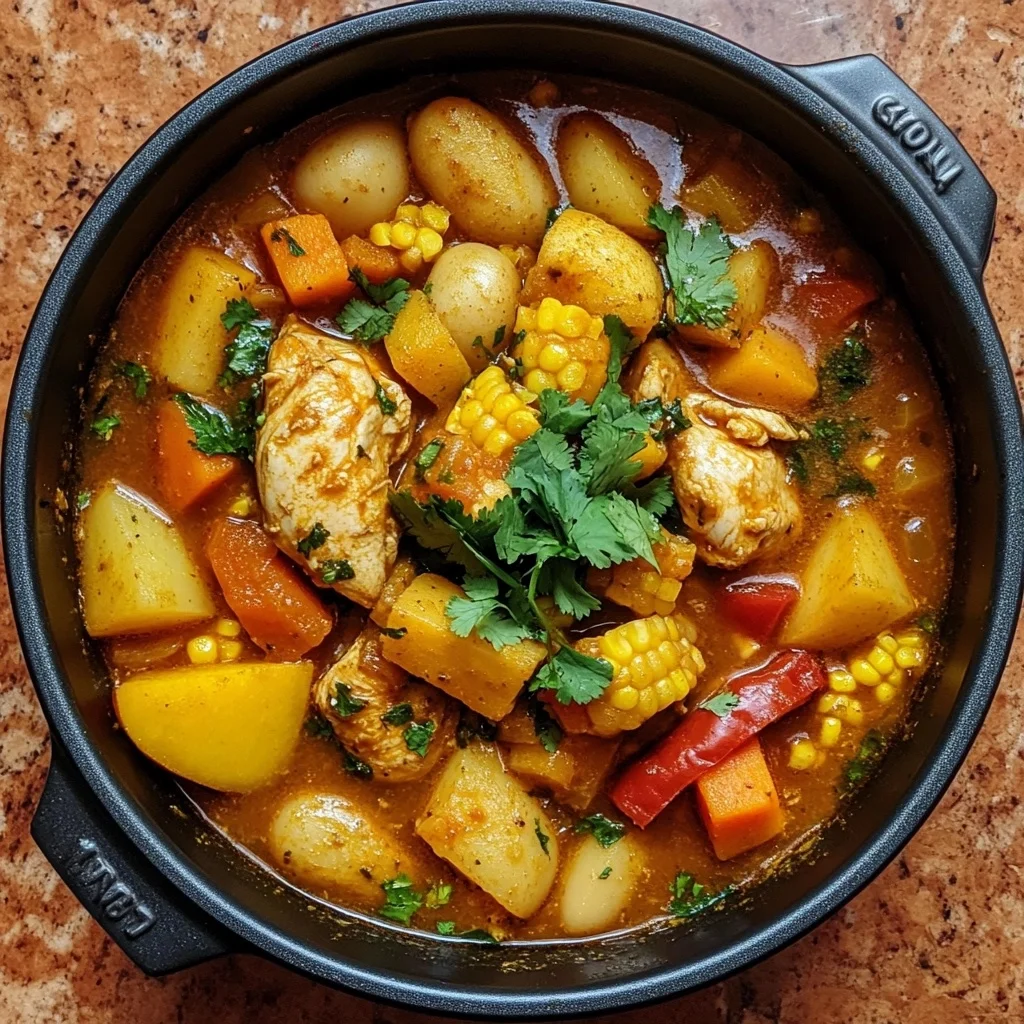Introduction
Sancocho is more than just a dish; it’s a culinary celebration that brings families together, warms hearts, and fills homes with irresistible aromas. This traditional stew, cherished in various Latin American countries, is a testament to the rich tapestry of flavors and ingredients found in the region. Whether you’re looking for a comforting meal for a chilly evening or a satisfying dish to share with loved ones, this ultimate Sancocho recipe is your go-to guide.
In this article, we will explore how to create the perfect Sancocho, using a combination of tender chicken (or chickpeas for a plant-based twist), fresh vegetables, and an array of spices. Not only will you learn how to prepare this delightful stew, but you’ll also discover tips on serving, nutritional benefits, and answers to common questions. So, grab your apron, and let’s dive into the world of Sancocho!
Ingredients
To create this mouth-watering Sancocho, you’ll need the following ingredients:
- 1 lb chicken pieces (or use chickpeas for a plant-based option)
- 6 cups water
- 2 large potatoes, chopped
- 2 sweet potatoes, chopped
- 1 corn on the cob, cut into pieces
- 1 small onion, chopped
- 2 garlic cloves, minced
- 1 bell pepper, chopped
- 1 tsp cumin
- 1 tsp oregano
- Salt and pepper to taste
- Fresh cilantro for garnish
Instructions
Creating this savory Sancocho is easier than you might think. Follow these simple steps to bring this traditional dish to life:
- Prepare the Base
In a large pot, bring 6 cups of water to a boil. Add the chicken pieces (or chickpeas if making the plant-based version) and cook for 15 minutes. This will allow the proteins to infuse their flavors into the broth. - Sauté the Aromatics
Add the chopped onion, minced garlic, and bell pepper to the pot. Sprinkle in the cumin, oregano, salt, and pepper. Cook this mixture for about 5 minutes, allowing the vegetables to soften and the spices to release their aromas. - Incorporate the Vegetables
Stir in the chopped potatoes, sweet potatoes, and corn pieces. Reduce the heat to a simmer and let the mixture cook for approximately 20 minutes, or until the vegetables are tender and have absorbed the flavors of the broth. - Adjust the Seasoning
Taste your Sancocho and adjust the seasoning as needed. You may want to add more salt or pepper, depending on your preference. - Serve and Garnish
Serve the Sancocho hot, garnished with freshly chopped cilantro. This vibrant herb adds a refreshing contrast to the rich flavors of the stew.
Nutrition Facts
Understanding the nutritional profile of your meals is key to maintaining a balanced diet. Here’s what you can expect from a serving of this ultimate Sancocho:
- Calories: 350
- Protein: 25g
- Carbohydrates: 45g
- Fat: 10g
- Fiber: 6g
This hearty stew is not only delicious but also packed with essential nutrients that provide energy and support overall health. It’s a balanced meal option that combines proteins, carbohydrates, and fiber to keep you satisfied and nourished.
How to Serve
Sancocho is not only a beloved traditional dish, but it is also incredibly versatile, allowing for various serving styles that can enhance your dining experience. Below are several detailed suggestions on how to serve this hearty stew, ensuring that every meal is memorable and satisfying.
As a Standalone Dish
Sancocho can be enjoyed as a standalone dish, making it the star of your meal. To do this, ladle a generous portion into deep bowls, allowing the vibrant colors and textures of the ingredients to shine. Pairing it with crusty bread or a fluffy serving of rice is highly recommended, as these accompaniments are perfect for soaking up the rich and flavorful broth. Consider offering a variety of breads, such as a rustic sourdough or a soft Cuban bread, to cater to different tastes. If opting for rice, jasmine or basmati rice can add a fragrant touch that complements the stew beautifully.
With Avocado
Elevate your Sancocho experience by adding slices of creamy avocado on top just before serving. The buttery texture of ripe avocado adds a luxurious richness that balances the robust flavors of the stew. For added flair, you can sprinkle some lime juice over the avocado slices to enhance their flavor and prevent browning. Additionally, consider serving the avocado in a separate dish, allowing guests to add as much or as little as they like, catering to personal preferences.
With Hot Sauce
For those who enjoy a little kick in their meal, offering hot sauce alongside Sancocho can take the dish to new heights. The heat from the sauce can elevate the complex flavors of the stew, adding an exciting layer of spice. Consider providing a selection of hot sauces—from mild to fiery—so that everyone can customize their bowl to their liking. For an added touch, you might create a small tasting station with different types of hot sauces, allowing guests to explore and find their favorite.
Family Style
One of the most delightful ways to serve Sancocho is family-style. This communal approach not only makes for a visually appealing presentation but also encourages interaction among diners. Place the pot of Sancocho in the center of the table, surrounded by bowls of rice, crusty bread, and other accompaniments. Provide ladles and serving spoons, allowing everyone to serve themselves at their leisure. This method fosters a sense of togetherness, as family and friends share stories and laughter while enjoying the meal. To enhance the experience, consider setting a beautiful table with colorful plates and fresh flowers, creating a warm and inviting atmosphere.
With Fresh Herbs and Lime
To add a burst of flavor and freshness to your Sancocho, consider garnishing each bowl with freshly chopped herbs, such as cilantro or parsley. These herbs not only enhance the visual appeal of the dish but also add a fragrant aroma and a hint of brightness that can balance the richness of the stew. A wedge of lime on the side allows guests to squeeze fresh juice over their portion, introducing a zesty element that complements the hearty flavors beautifully.
Accompanying Sides
While Sancocho is hearty enough to stand on its own, you may choose to offer a selection of sides to round out the meal. Popular options include fried plantains (tostones or maduros), which provide a sweet and savory contrast, or a simple green salad with a light vinaigrette to cleanse the palate. Corn on the cob or a side of black beans can also be delightful additions that echo the traditional flavors of the dish.
By considering these various serving options, you can create a memorable and enjoyable dining experience centered around Sancocho. Whether you choose to serve it as a standalone dish, enhance it with avocado and hot sauce, or embrace a family-style approach, this versatile stew will surely please all palates and bring everyone together.
Additional Tips
To ensure your Sancocho is the best it can be, consider these additional tips that will enhance both flavor and presentation:
Choose Your Protein Wisely
When selecting your protein for Sancocho, think about how each option can contribute to the overall depth of flavor. If you opt for chicken, consider using bone-in pieces such as thighs or drumsticks. The bones release collagen during cooking, resulting in a richer, more flavorful broth. For those preferring red meat, options like beef shank or short ribs can offer a robust taste. Alternatively, if you’re looking for a plant-based option, chickpeas are an excellent choice. They not only provide a hearty texture but also contribute a significant amount of protein and fiber, making your stew both satisfying and nutritious.
Additionally, don’t shy away from combining proteins; a mix of chicken and beef or even sausage can create a more complex flavor profile that captures the essence of traditional Sancocho.
Experiment with Vegetables
Sancocho is a versatile dish, and the vegetables you choose can greatly influence the overall taste and texture. While traditional recipes often include staples like potatoes, corn, and cassava (yucca), feel free to get creative! Adding carrots will introduce a subtle sweetness, while green plantains can lend a unique starchiness that complements the broth.
You might also consider adding seasonal vegetables such as bell peppers, sweet potatoes, or even green beans for added color and nutrients. If you’re feeling adventurous, try incorporating some leafy greens like kale or spinach towards the end of cooking for a vibrant touch and extra vitamins. Remember that the goal is to create a balance of flavors and textures, so mix and match based on what’s available and your personal preferences.
Make Ahead for Enhanced Flavor
Sancocho is a dish that truly benefits from time. Making it a day ahead allows the flavors to meld beautifully, resulting in a broth that is rich and layered. The spices and ingredients have time to interact, leading to a more balanced and satisfying stew. When reheating, you might find that the stew thickens slightly; simply add a splash of water or broth to achieve your desired consistency.
If you plan to serve Sancocho at a gathering, consider preparing it in advance and letting it sit in the refrigerator overnight. Just remember to give it a good stir and a taste test before serving to adjust any seasonings that may have mellowed during storage.
Storage Tips
Proper storage is key to enjoying your Sancocho beyond the initial serving. Store any leftovers in an airtight container in the refrigerator, where they will stay fresh for up to three days. When reheating, do so gently on the stovetop, adding a bit of water or broth if needed to restore the stew’s original consistency.
For longer-term storage, Sancocho freezes exceptionally well. Allow the stew to cool completely before transferring it to freezer-safe containers or resealable plastic bags. When stored this way, it can last for up to two months. When you’re ready to enjoy it again, simply thaw it in the refrigerator overnight and reheat on the stove, stirring occasionally, until heated through. This makes Sancocho a great option for meal prep, ensuring you always have a comforting, homemade meal on hand.
By following these additional tips, you can elevate your Sancocho, creating a dish that not only satisfies but also delights the palate with its rich flavors and comforting warmth. Enjoy the process of experimenting and making this beloved stew your own!
FAQs
Q: Can I use other spices in my Sancocho?
A: Absolutely! While cumin and oregano are traditional, feel free to experiment with other spices like paprika or turmeric for a unique twist.
Q: How can I make my Sancocho more filling?
A: Adding ingredients like rice or beans can make the stew more hearty and filling, perfect for a complete meal.
Q: Is there a vegetarian version of Sancocho?
A: Yes, you can easily make a vegetarian Sancocho by using chickpeas instead of chicken and incorporating a variety of vegetables to enhance the stew’s richness.
Q: What is the best way to reheat Sancocho?
A: Reheat Sancocho gently on the stovetop over low heat, stirring occasionally, until it’s heated through. This helps maintain the texture and flavor of the stew.
Conclusion
The ultimate Sancocho recipe is a culinary masterpiece that brings together the best of Latin American flavors in a single pot. With its tender chicken (or chickpeas), hearty vegetables, and aromatic spices, this stew is sure to become a favorite in your household. The combination of root vegetables, corn, plantains, and yuca, all simmered together in a flavorful broth, creates a dish that is as nourishing as it is satisfying. Whether you’re serving it for dinner or saving it for a cozy lunch the next day, Sancocho offers a comforting embrace in every bowl.
By following the steps outlined in this article, you can master the art of making Sancocho and enjoy a dish that’s both delicious and nutritious. This rich, flavorful stew is perfect for feeding a crowd or enjoying leftovers throughout the week. Remember to make it your own by experimenting with different ingredients, such as adding pork or beef, or adjusting the seasoning to your taste. You can also customize the texture by adding more or fewer vegetables. So, the next time you crave something warm and satisfying, let this ultimate Sancocho recipe be your guide to culinary bliss. It’s the perfect comfort food for any occasion.
Print
Vegetable Curry with Coconut Milk
Ingredients
Ingredients
To create this mouth-watering vegetable curry with coconut milk, you’ll need the following ingredients:
- 1 can coconut milk
- 2 cups mixed vegetables (carrots, bell peppers, peas)
- 1 onion, chopped
- 2 garlic cloves, minced
- 1 tbsp ginger, grated
- 2 tbsp curry powder
- 1 tbsp olive oil
- Salt and pepper to taste
- Fresh cilantro for garnish
Instructions
Preparing this vegetable curry is straightforward and takes less than half an hour. Follow these simple steps to make a delicious curry:
- Heat olive oil in a large pan over medium heat.
- Add onion, garlic, and ginger; sauté until soft. This should take about 3-4 minutes.
- Stir in curry powder and cook for 1 minute. This will release the spices’ aroma, enhancing the flavor of your curry.
- Add mixed vegetables and coconut milk; bring to a simmer. Ensure the vegetables are well-coated with the coconut milk and curry mixture.
- Cook for 15-20 minutes until the veggies are tender. Stir occasionally to prevent sticking.
- Season with salt and pepper according to your taste preferences.
- Garnish with cilantro and serve hot. The cilantro adds a fresh and vibrant touch to the dish.
Nutrition
- Serving Size: one normal portion
- Calories: 180
- Sugar: 2g
- Fat: 15g
- Carbohydrates: 12g
- Fiber: 4g
- Protein: 3g





